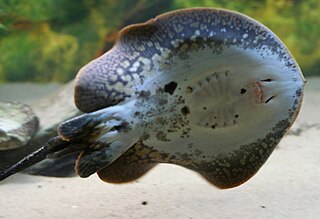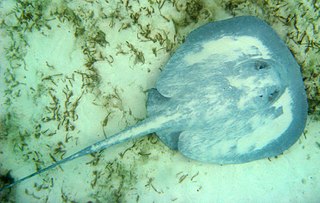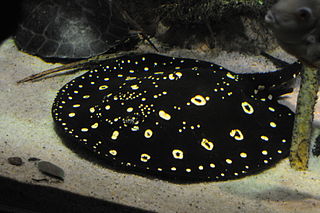
River stingrays or freshwater stingrays are Neotropical freshwater fishes of the family Potamotrygonidae in the order Myliobatiformes, one of the four orders of batoids, cartilaginous fishes related to sharks. They are found in rivers in tropical and subtropical South America. A single marine genus, Styracura, of the tropical West Atlantic and East Pacific are also part of Potamotrygonidae. They are generally brownish, greyish or black, often with a mottled, speckled or spotted pattern, have disc widths ranging from 31 to 200 centimetres (1.0–6.6 ft) and venomous tail stingers. River stingrays feed on a wide range of smaller animals and the females give birth to live young. There are more than 35 species in five genera.

The long-tailed river stingray or antenna ray is a species of freshwater stingray in the family Potamotrygonidae. It is found in the Amazon basin in South America, ranging from Ecuador to Belém. It lives in the main channel of the Amazon River and lower parts of its major tributaries.

The ocellate river stingray, also known as the peacock-eye stingray or black river stingray, is a species of freshwater stingray in the family Potamotrygonidae. It was the first species to be described in the family and is also the most widespread, ranging throughout much of the Río de la Plata, Amazon, Mearim and Orinoco basins in tropical and subtropical South America. It is sometimes kept in aquaria.

The chupare stingray or Caribbean whiptail stingray is a species of stingray in the family Potamotrygonidae, found in the western Atlantic Ocean from the Gulf of Campeche to Brazil, including the Antilles. The presence of this species in the Gulf of Mexico has not been confirmed. It also occurs in the Bahamas. It usually inhabits sandy substrates, sometimes near coral reefs, and is an infrequent visitor to the Amazon River estuary. Leonard Compagno doubted the taxonomic validity of this species in his 1999 Checklist of Living Elasmobranchs.

The bigtooth river stingray or Tocantins River ray is a species of freshwater fish in the family Potamotrygonidae. It is endemic to the lower Tocantins basin and Araguaia basin in Brazil, and prefers muddy bottoms. It is sometimes kept in aquaria. This stingray is generally common and its population increased after the Tucuruí Dam was completed, unlike many other species in its range.

The Xingu River ray, white-blotched river stingray, or polka-dot stingray is a species of freshwater fish in the family Potamotrygonidae. It is endemic to the Xingu River basin in Brazil and as such prefers clear waters with rocky bottoms. It is sometimes kept in aquaria, like its more common relative the Motoro.
The raspy river stingray, mosaic stingray or arraia is a species of freshwater fish in the family Potamotrygonidae. This stingray is endemic to the Amazon basin in Brazil, where known from the Amazon–Pará River, the Madeira River basin, Uatumã River and lower Tocantins River.
Potamotrygonocotyle is a genus of monogeneans that parasitise stingrays of the genus Potamotrygon. From 1981 the genus contained only one member, Potamotrygonocotyle tsalickisi, until four new species were described in 2007.

The whiptail stingrays are a family, the Dasyatidae, of rays in the order Myliobatiformes. They are found worldwide in tropical to temperate marine waters, and a number of species have also penetrated into fresh water in Africa, Asia, and Australia. Members of this family have flattened pectoral fin discs that range from oval to diamond-like in shape. Their common name comes from their whip-like tails, which are much longer than the disc and lack dorsal and caudal fins. All whiptail stingrays, except the porcupine ray, have one or more venomous stings near the base of the tail, which is used in defense. In order to sting their victims, they jerk their tails as the stinger falls off and stays in the wound that they have created. The stinger of a whiptail stingray is pointy, sharp with jagged edges. They range in size from 0.18 to 2.0 m or more across in the case of the smalleye stingray and giant freshwater stingray.

The Pacific chupare or Pacific whiptail stingray is a species of stingray in the family Potamotrygonidae. It has been reported off the Pacific coast of Central America from Oaxaca, Mexico to Costa Rica, and also around the Galapagos Islands. It is usually found in shallow water on soft silty or muddy flats; it is unknown whether this species is tolerant of low salinity like the related chupare stingray. Leonard Compagno doubted the taxonomic validity of this species in his 1999 Checklist of Living Elasmobranchs.

The porcupine river stingray is a species of river stingray in the family Potamotrygonidae, the type of the Potamotrygon genus. It is found in the basins of the Paraná and Paraguay River basins in South America. Most chemical weathering of minerals seems to take place in the upland drainage basins rather than on the floodplains, and most major solutes display conservative mixing in the river-floodplain system. The population in the Rio Negro basin was described as a separated species, P. wallacei, in 2016.

The short-tailed river stingray is a species of river stingray native to the Río de la Plata Basin in South America. It is sometimes known as the giant freshwater stingray, but this name is typically used for the southeast Asian Urogymnus polylepis.
Heliotrygon is a genus of freshwater stingrays in the family Potamotrygonidae. The genus is endemic to the Amazon basin in South America. Despite being discovered decades earlier, the genus was only scientifically described in 2011. They mainly live in deep river channels, but approach the shore at night to feed on fish.
Potamotrygon tatianae, the Tatiana's river stingray, is a species of river stingray (Potamotrygonidae) endemic to the Madre de Dios River and upper Madeira River basins in Peru.
Heliotrygon gomesi, or Gomes's round ray, is a species of freshwater stingray native to the western Amazon basin in South America, specifically Brazil. It is the type species of its genus. It spends the day in deep river channels, but moves closer to the shore at night to feed.

Paratrygon is a genus of cartilaginous fish in the family Potamotrygonidae.

Potamotrygon falkneri, the largespot river stingray or reticulated freshwater stingray, is a species of freshwater stingray in the family Potamotrygonidae from tropical and subtropical South America. It is sometimes seen in the aquarium trade, but requires a very large tank.

Potamotrygon tigrina, also known as the tiger river stingray, is a species of freshwater ray in the family Potamotrygonidae. This endangered species is endemic to black- and whitewater rivers in the upper Amazon basin in northeastern Peru. It is sometimes kept in aquariums and has been bred in captivity, but it is generally a sensitive species.

Styracura is a genus of stingray in the family Potamotrygonidae and the only genus in the subfamily Styracurinae. The two species in this genus were formerly included in Himantura, but were moved to Styracura in 2016 based on morphology and molecular evidence. Unlike other members of the family Potamotrygonidae, also known as freshwater stingrays, Styracura are found in the tropical West Atlantic and East Pacific.

Potamotrygon rex, the great river stingray, is a species of freshwater stingray belonging to the family Potamotrygonidae, native to South America in the Neotropical region. P. rex, along with some other Potamotrygon species form a sub-species group known as "black stingrays" known by their similar features and their locality to rivers draining the Central Brazilian Shield. Specifically, it is native to the Rio Tocantins in the central Brazilian state of Tocantins. It is quite a large organism, weighing up to 20 kg. Its appearance is dark brown to blackish with distinct clusters of yellow-orange spots around similarly colored ocelli on its dorsal side. Distinguishing features include broad pelvic-fin apices, lack of labial grooves, irregular double row of dorsal tail thorns, and having two angular cartilages associated with each hyomandibula.













